Have you ever heard of marimos, the so-called “moss balls” in the aquarium world?
Despite their nickname, they are not actually moss but a type of green algae known as Aegagropila linnaei.

Interestingly, marimos have become quite popular in recent years due to their unique and eye-catching appearance.
These spherical-shaped algae balls have a velvety texture and can grow up to several inches in diameter.
They are also known for their low-maintenance care requirements.
It’s worth noting that the current regulations in the US regarding aquarium ownership and trade are quite different, particularly due to the introduction of invasive species such as zebra mussels – marimos hitchhikers.
If you’re interested in learning more about this issue and how it affects the aquarium hobby, read on to the next paragraph.
Is it Safe to Order Moss Balls?

Not yet. The US Fish and Wildlife Service still recommends that any marimo moss balls purchased after February 1, 2021, be destroyed and disposed of properly.
Their website provides detailed instructions on how to safely do this.
In addition, you may want to verify that the procedure you use complies with local state and animal welfare laws.
Zebra mussels (Dreissena polymorpha) are an aggressively invasive species that can quickly overtake and permanently harm natural waterways.
The US Geological Survey (USGS) first received a report of marimo moss balls contaminated with zebra mussels from a pet store in Seattle in March of 2021.
They actively track additional reports and record them in the USGS Nonindigenous Aquatic Species database.
Multiple states have issued agricultural quarantines of these moss balls to protect uncontaminated waterways as recently as May 8, 2021.
Keep an eye on the US Fish and Wildlife Service website to learn when marimo moss balls will again be safe to purchase.
In this article
- Is it Safe to Order Moss Balls?
- In the Wild
- Marimo Moss Ball Care
- How do I pick out a healthy marimo ball?
- Introducing your marimo moss to its new home
- Tank Mates
- What’s on my marimo moss ball?
- Why is my marimo moss floating?
- How do I propagate my marimo moss balls?
- My marimo ball is falling apart, what do I do?
- My marimo moss has brown spots, what do I do?
- Good luck and happy marimo-keeping!
In the Wild
Marimos form massive colonies in Japan’s Lake Akan and throughout lakes in Europe.
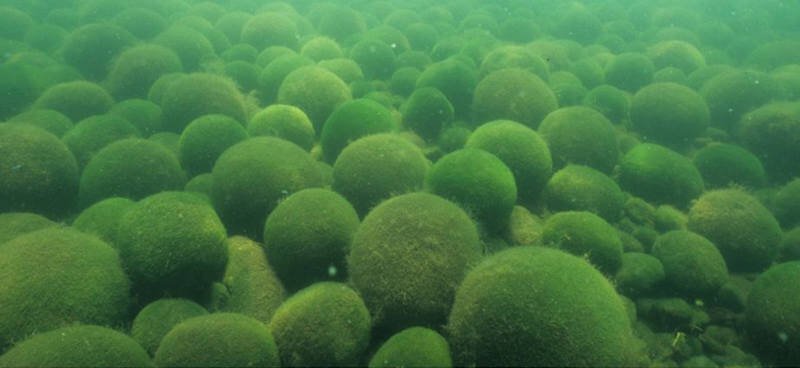
Because of their limited geographic range, Japan considers them a natural monument, and they’re listed as threatened in several countries.
Marimo translates to “lake ball” in English – a fitting name since they’re literally giant balls of algae filaments found on lake floors.
Currents in shallower parts of the lake roll them around, giving them their iconic shape.
The spherical colonies are usually comprised of a few layers and can grow up to 12” (30 cm) in diameter.
Wild colonies that form in the deeper, calmer parts of the lake form flattened algae mats and clumps which cover rocks and patches of the lake floor.
The moss balls available in the aquarium trade aren’t harvested directly from these colonies, though, as they’re a protected species in most of their native ranges.
In fact, most of the marimo moss available on the market today come from Ukraine. Even the ones available for sale in Japan have European origins.
All the suppliers, growers, and wholesalers surveyed in a 2010 study reported Ukraine as their stock’s country of origin.
Marimo Moss Ball Care
Overview
- Low light
- Low maintenance
- Slow growth
- Prefer colder water 65-75°F (18-24°C), will tolerate temps up to 85°F or 29°C
- Can be kept by themselves or placed in a stocked freshwater aquarium
- Require dechlorinated water
Marimo moss balls are among the easiest aquarium “plants” to keep and are recommended for aquarists of all experience levels, including beginners.
Because they originally come from lake bottoms, they do quite well in low-light tanks.
They also tolerate a wide range of temperatures, from the mid-60s to mid-80s (Fahrenheit), making them fantastic additions to nearly any tank.
Marimo algae growth is slow, with the balls increasing only about .2 inches (5 mm) in diameter each year.
Because they’re so tolerant, you can use them to enhance the aesthetics of nearly any container so long as they have dechlorinated water and a light source.
They’re perfect for fishbowls, small jars, and even vases but will also do well in full-sized aquariums.
They can be housed alone or with fish, invertebrates, and other organisms.
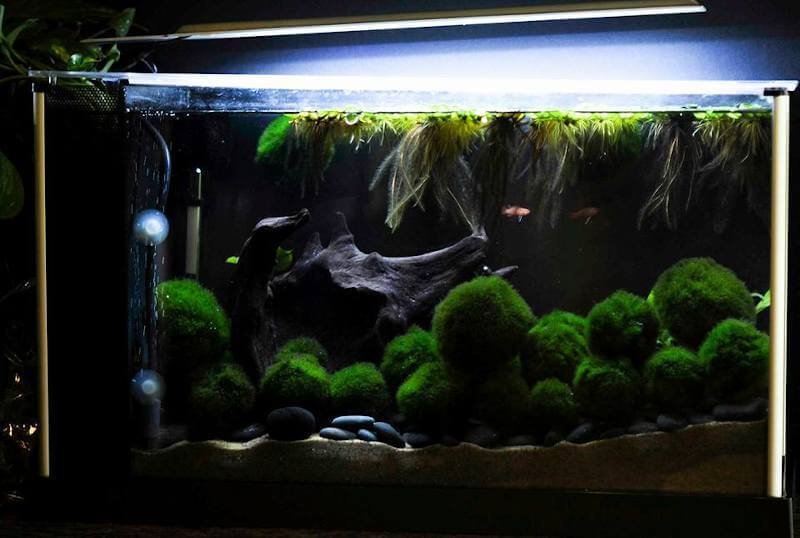
In terms of tank maintenance and care requirements, these guys don’t require very much.
If you’re keeping them in a freshwater aquarium with stock, the most convenient time to clean them would be during weekly or bi-weekly water changes.
If they’ve collected any debris, run them under the faucet or swish them around in the water. Then, roll them in your hands to reshape them before returning them to the tank.
If your marimos are being kept in a single-species tank, be sure to perform water changes at least every 2-3 weeks.
Between water changes, feel free to move them around their tank or bowl. Rolling marimo balls around will help them retain their shape, stimulate growth, and prevent dead spots.
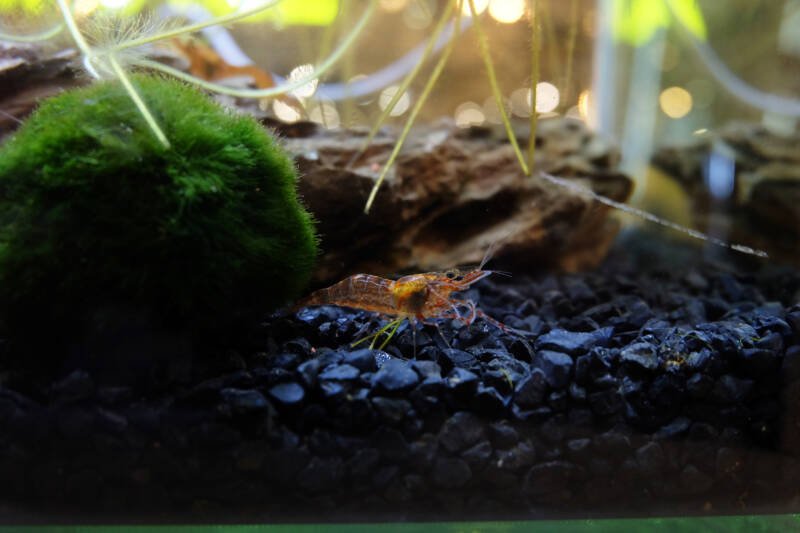
Helpful Tips
- Keep the tank out of direct sunlight so as not to burn them
- Don’t forget to dechlorinate tap water and keep a regular water change schedule
- If you’re keeping your marimo moss ball in a container, leave it open whenever possible to help with surface gas exchange
- Put your moss balls in the refrigerator overnight a couple of times a month. The colder temperature is beneficial for them.
- Decorate your marimo tank however you want, give it a name, and remember to have fun with it!
How do I pick out a healthy marimo ball?
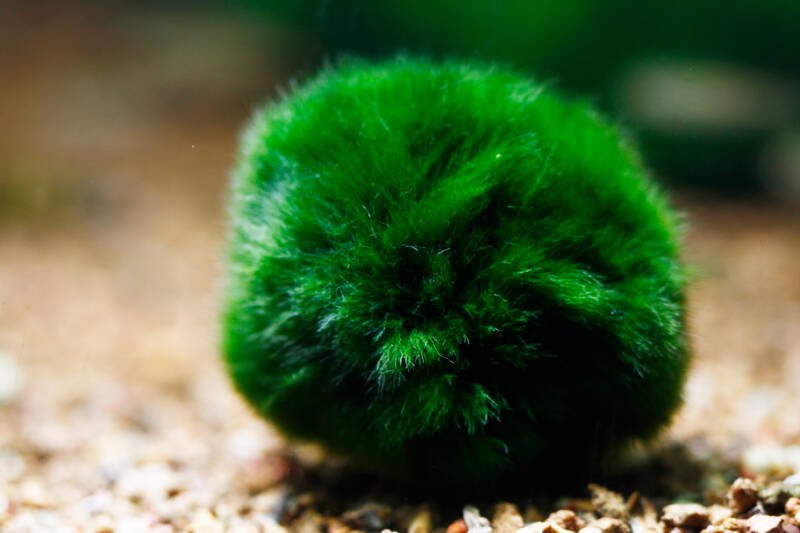
Marimo balls are often available for purchase at the store and are widely available online!
Healthy marimo moss balls
- are deep to bright green in color
- don’t have brown or yellow spots
- have the same consistency all the way through
- are round (or at least roundish) and not excessively lumpy
- have a velvety or fluffy appearance
In Store

You can find moss balls at both local mom ‘n’ pop shops and larger chain stores (like Petco or PetSmart).
Most stores tend to sell larger specimens that are about 1-2 inches across. On occasion, Petco will stock trios of smaller .5-1-inch diameter ones for the same price as the large 1-2-inch (2.5-5 cm) spheres.
When picking out a marimo moss ball to bring home, you want to look for bright or dark greens and avoid faded or dull coloration.
I would also advise against picking one that’s lumpy, has a matte surface, or doesn’t have a roundish shape.
If you end up bringing home a ball with brown or yellow spots, you might need to trim those dead or dying bits away. If you’re not comfortable with trimming, make sure yours doesn’t have any off-colored patches before heading to the checkout line.
If you have the chance to handle the moss ball before you pay for it, the best way to check its health and quality is to squeeze it.
Sometimes they look perfectly healthy from the outside: great coloration, exceptionally round, and extra fluffy, but they may be hollow or rotting on the inside. The only way to know if this is the case without cutting into it is to squeeze it.
If it feels squishy or doesn’t hold a round shape when you squeeze it, it’s likely to be less dense in the center.
If it smells bad, it’s probably dying or rotted inside. If it feels reasonably solid in the center and keeps its shape, then you’re good to go!
Online
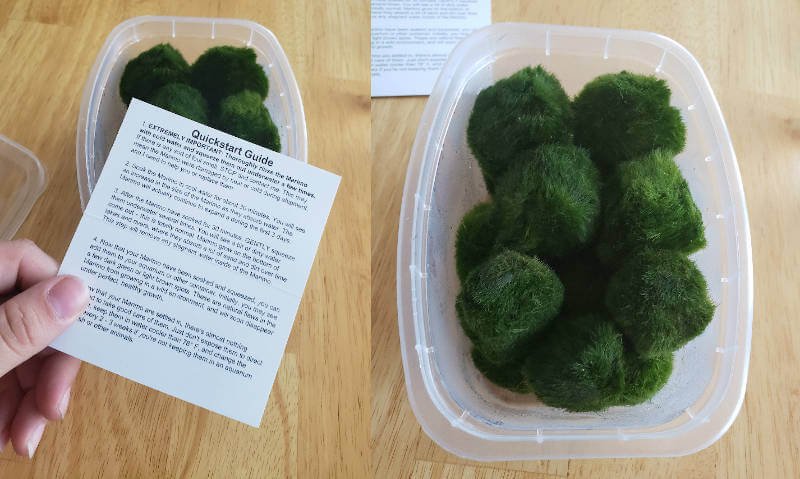
Marimo moss balls are available online through most aquatic plant and stock websites. They’re also available from places like eBay and Amazon.
Because you won’t be able to inspect them until you receive them, I cannot stress this enough: read the reviews.
Although there are plenty of listings on the site, I generally advise against buying from eBay.
I’ve heard too many stories about people ordering “marimo moss balls” or “moss balls” and not receiving the marimo that was pictured in the product listing. Some people end up with balls of green hair algae or even java moss wrapped around a plastic ball instead.
There’s nothing inherently wrong with buying plants on eBay, but I still recommend purchasing from a trusted seller.
Ordering from a reputable seller will help to guarantee that your marimo arrives healthy. Most sellers will also send replacements in case any are damaged (make sure to read the seller’s Damaged or DOA Policies before ordering).

Personally, I recommend buying from AquaticArts.com or PlantsForPets.com (both are run by the same company, their product is pictured above).
Their prices are fair, and they usually throw one or two extras to cover any that may have been damaged or died in transit.
You can also find the Aquatic Arts brand on Amazon if you’re a fan of Amazon Prime.
The other company I recommend purchasing from is Luffy, which is accessible through Amazon as well.
Generally, I’ll purchase mini marimo balls (under an inch) from Luffy and larger ones through Aquatic Arts.
I’ve ordered from both multiple times and haven’t had any issues with either company thus far.
The last thing to consider when purchasing online is shipping. If temperatures are over 85-90°F (29-32°C) or under 55 °F (13°C) where you live, make sure to keep an eye on your shipment’s tracking.
Most websites give warnings about shipping time and temperature, but I’d hate for you to make the same rookie mistake I did.
The first time I ordered moss balls, I didn’t think about them being delivered and then sitting in a 120°F metal mailbox all day.
When I finally came home and opened their package, let’s just say they didn’t look so great. Some of them were beyond saving, but a few survived after some TLC and spa nights in the fridge.
Introducing your marimo moss to its new home

Before placing your marimo ball into its new freshwater aquarium home, you’ll need to give it a good once-over to check for hitchhikers (see What’s on My Marimo Ball? for more information).
You’ll also need to give it a good rinse and soak! Rinse it under running tap water or swish it around in a bowl of clean tap water until you don’t see any debris or sand and the water runs clear.
Reroll them with your hands and let them soak in clean, dechlorinated water before adding them to the new tank.
Tank Mates
Betta Fish

Bettas will often stop to rest on these fluffy green moss balls but won’t damage them. They make fantastic betta tank mates!
Goldfish, Axolotls, and Turtles
There are pros and cons when it comes to housing marimo moss balls with goldfish, axolotls, or turtles.

Both goldfish and axolotls prefer cooler water just like moss balls, which is a plus. Marimo balls also pair well with goldfish and freshwater turtles, who can roll them around and play with them (beneficial to the moss and the animal!).
Some goldfish will pick at them, some might leave them alone, and others will completely destroy them. The same generally applies to axolotls and turtles.
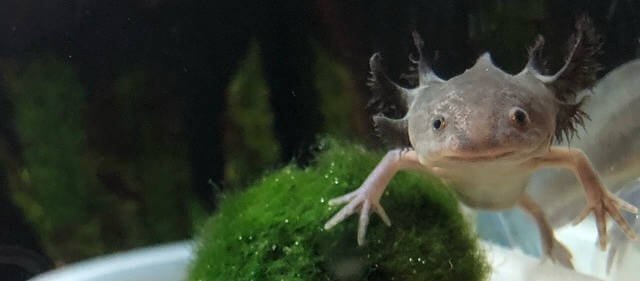
Because of the way axolotls quickly suck in prey, they may choke on smaller marimos or bits of larger marimo balls.
If your animal is breaking apart your moss balls, it may be best to remove them from the fish tank for the safety of your animal and the well-being of the algae.
Crayfish
Crayfish are notorious for tearing up aquarium plants and redecorating their tanks to suit their liking.
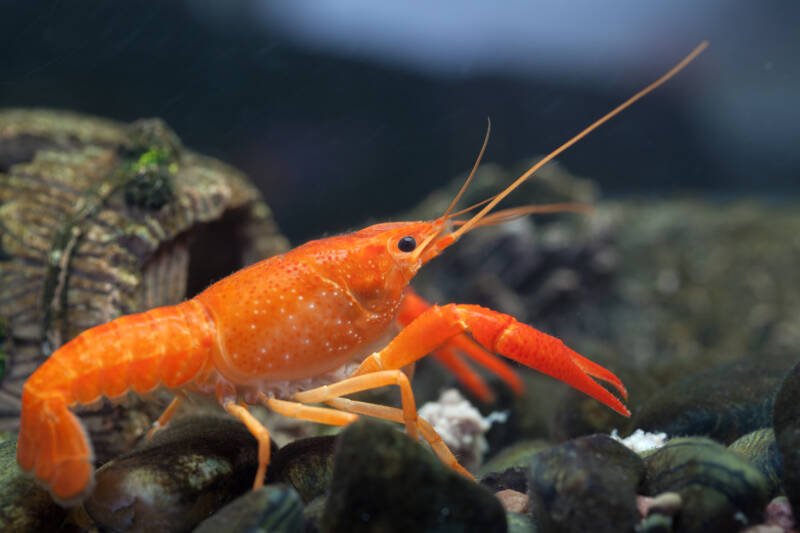
Some larger types of crayfish may tear apart your moss balls. Species of dwarf crayfish (such as the one pictured above) tend to just pick out bits of food that have become stuck to them.
Shrimp and Snails
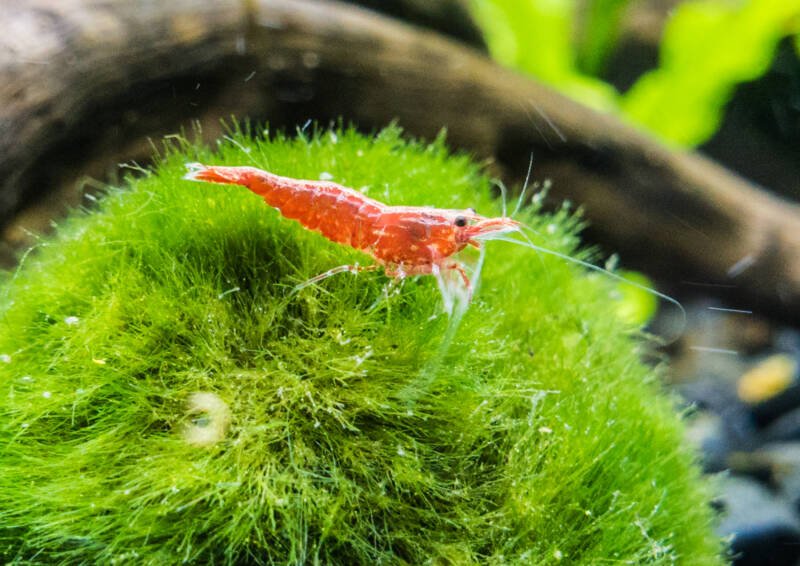
Live plants, mosses, and other algae are all highly beneficial in freshwater shrimp and snail tanks, and marimo balls are no exception!
They provide plenty of surface area for biofilm to form, and they collect small bits of food and debris, providing an excellent grazing area for invertebrates.
Other fish
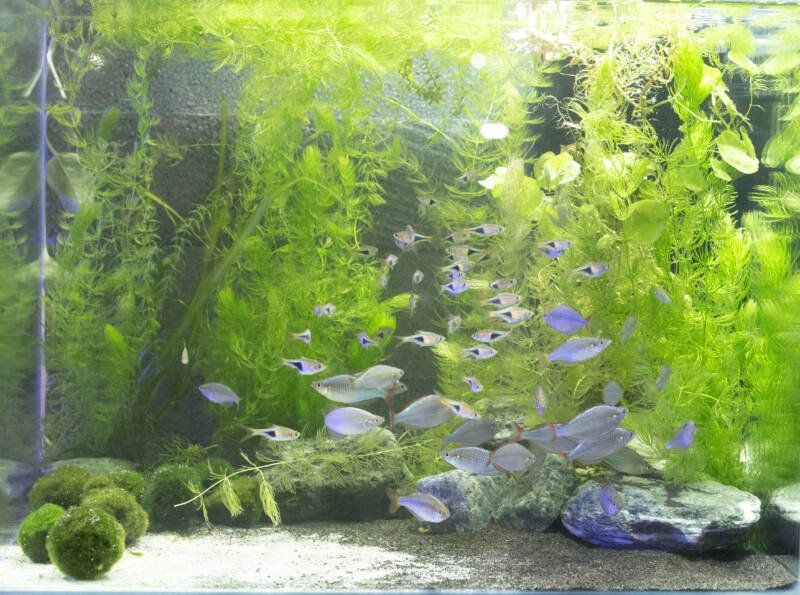
Marimo moss will do best in tanks when it’s left alone, aside from the occasional nudge or spin around the fish tank. This makes it ideal for fish tanks with non-aggressive freshwater fish.
What’s on my marimo moss ball?
Marimo moss balls pick up bits of debris and detritus as they grow or roll around on the bottom of their tanks, much as they would in freshwater lakes.
In fact, grains of sand are commonly found embedded in them. Sand doesn’t generally damage them, though, and can be easily rinsed off most of the time.
Just like aquarium plants, they can pick up hitchhiking pests, such as snails or eggs.
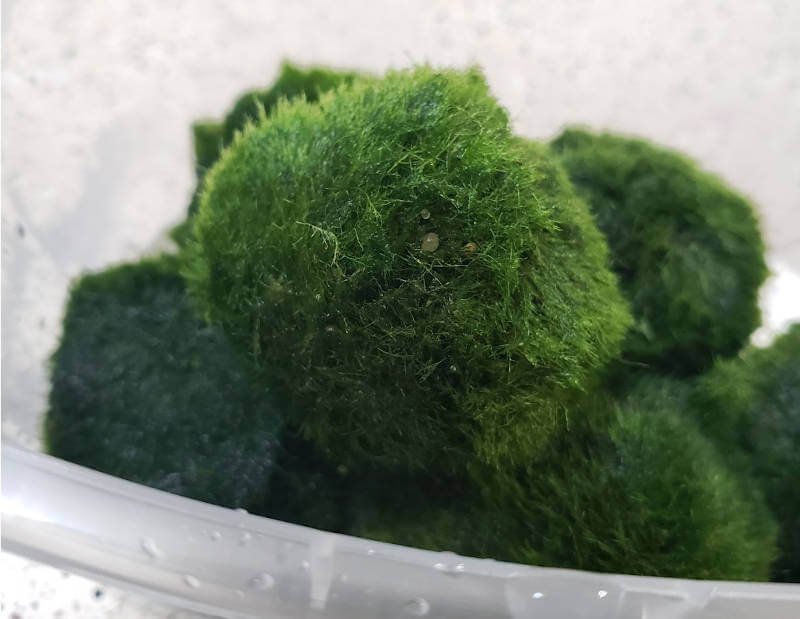
If you see anything you’re worried about, a quick bleach dip should kill any unwanted pests. Use a solution of 1 part bleach to 19 parts water and dip for 1-2 minutes. Remove your moss ball from the solution, then run it under cool water.
Lastly, place it in a bowl of clean water with a double dose of dechlorinator and let it soak for a few minutes. After this, it’s safe to add it back to the tank.
Why is my marimo moss floating?
Marimo balls perform photosynthesis, and one of the waste products of this process is oxygen. Sometimes you’ll see a tiny air bubble or two on your little ball of moss, which means it’s doing exactly what it’s supposed to do!
Oxygen trapped inside may cause it to float. The moss ball will sink again once the oxygen dissolves into the water or bubbles up to the top.
The other reason your marimo balls might float is that you’ve just put them in the tank. Air bubbles get trapped inside when they’re removed from the water.
They’ll sink eventually, but if you want them to sink right away you can give them a gentle squeeze underwater to release the excess oxygen.
How do I propagate my marimo moss balls?
Marimo balls’ growth rate may be slow, but increasing their number takes little effort. There are two main methods of propagation: splitting and pinching.
Splitting

Because Aegagropila linnaei doesn’t develop a kernel and the marimo balls are the same on the inside as on the outside, you can safely split one in half to create two. I find it easiest to search for the weak points with my fingers and just split them apart by hand.
Cutting with knives or scissors will give you the same result (though you might have more fuzz fallout if you take this route). This doesn’t hurt the organism in any way, and you can roll each half in your hands to reshape them.
When you do a water change or wash your moss balls, give them a good re-roll as well. Because they’re slow growers, it might take a while for them to regain their rotund appearance, but diligently rerolling them should help!
If they are a particularly awkward shape, you can also wrap some fishing line around them to help them grow back into a ball.
Pinching

Sometimes this species of algae will give off little buds. You can easily pinch these off with your fingers.
Since these buds tend to be small (the one pictured above is exceptionally tiny!), you probably won’t be able to use thread or fishing line, so just reroll them and you’re good to go.
My marimo ball is falling apart, what do I do?
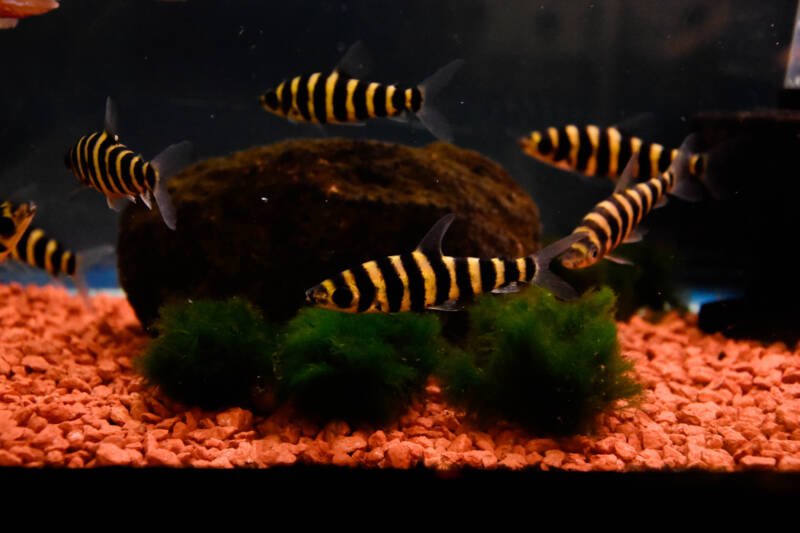
Sometimes marimos rot from the inside out, and you don’t know until they fall apart or split open. By then, it’s too late.
If this is the case, the best thing you can do is open it up (you should be able to pry it apart gently using your hands) and inspect the inside. If the inside smells or appears mushy or discolored, it’s best to remove all the unhealthy algae.

After you’ve removed all the yucky bits, you can re-roll the moss ball and sew it together with needle and thread or wrap some fishing line around it!
You can also leave it flat. In their natural habitat, marimos can grow in a few different forms, one of which is a mat that grows over rocks or on patches of the lake floor.
You can even tie it to some rocks or driftwood to create beautiful aquascaping pieces like the bonsai pictured above!
My marimo moss has brown spots, what do I do?
If you find a yellow or brown spot or other discoloration, it means the algae patches are dying. Occasionally this can be due to water quality or lighting.
Extra water changes and salt baths can help return these spots to their original color. If the algae in these spots have died or begin to smell, trim the dying patches off.
Then re-roll it with care every few days or wrap the fishing line around it to reshape it.
Brown spots can also be caused by sitting in one place for too long, so rolling or moving the moss balls around the aquarium should help prevent this issue.
Good luck and happy marimo-keeping!
If you have any questions or tips for other keepers, please feel free to leave a comment below!